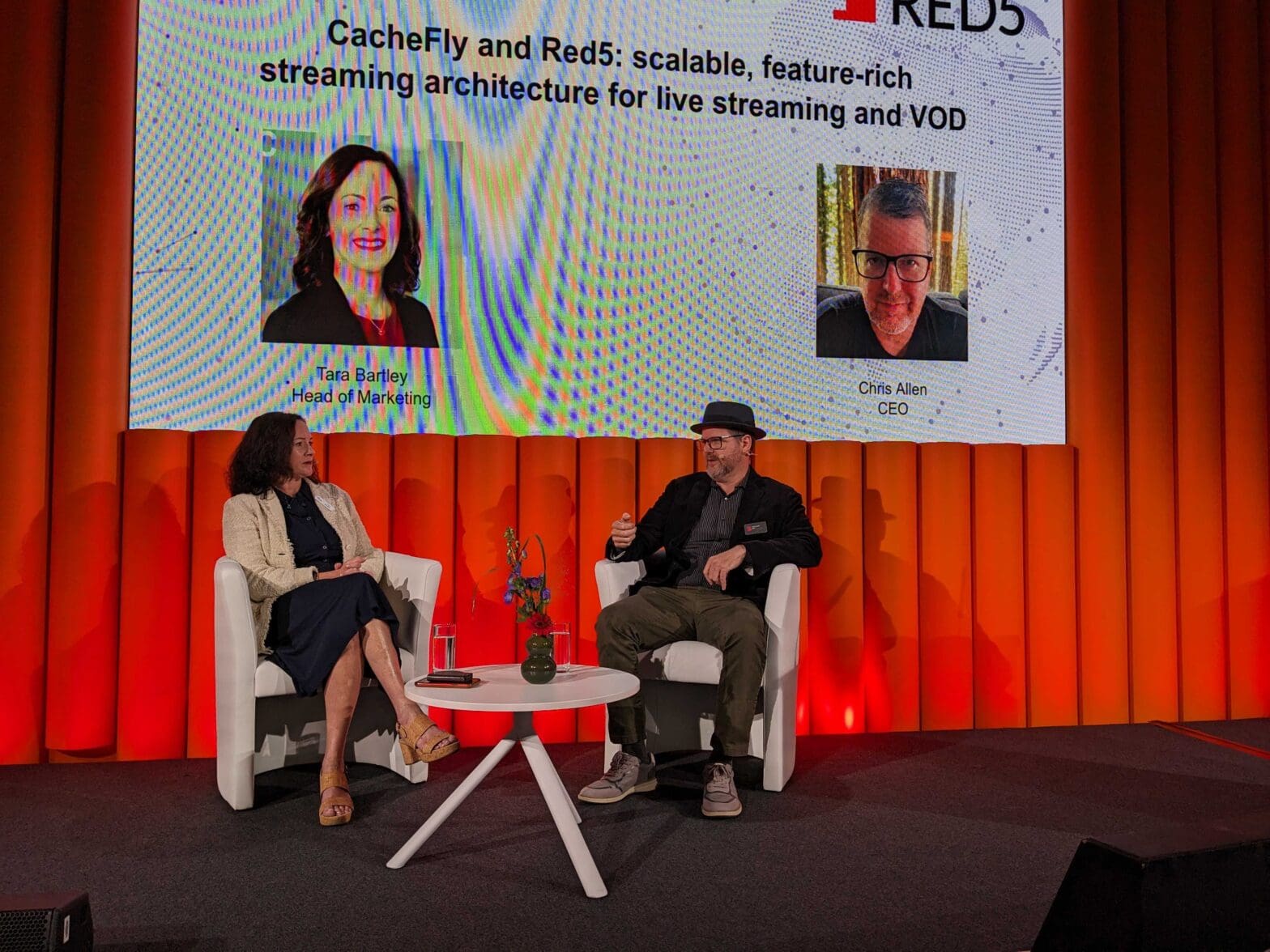The last update we shared was about what Red5 and CacheFly planned to present at IBC 2025. In this blog you will learn about some of the ways Red5 is facilitating the shift from one-way streaming to real-time interactive video that we saw at IBC 2025. You’ll discover new cross-vendor partnerships, the role of Red5’s… Continue reading Ground-Breaking Advances at IBC 2025 Put New Wind in Red5’s Sails
The last update we shared was about what Red5 and CacheFly planned to present at IBC 2025. In this blog you will learn about some of the ways Red5 is facilitating the shift from one-way streaming to real-time interactive video that we saw at IBC 2025. You’ll discover new cross-vendor partnerships, the role of Red5’s XDN Architecture in enabling AI-driven use cases, and how alliances with leaders like CacheFly and PubNub are expanding the ecosystem. You’ll also see why WebRTC remains central while alternatives like MOQ are being closely watched for the future.
Table of Contents
Watch a quick video overview from Chris Allen, our co-founder and CEO, on Youtube.
Real-Time Streaming at IBC 2025
The Red5 team’s recently concluded annual visit to IBC 2025 in Amsterdam proved to be more rewarding than ever as we encountered industry-wide agreement on the need to overcome the impediments to progress posed by the prevailing one-way streaming infrastructure.
In a chaotic market where margins are razor thin, impatience with the status quo pervaded the mid-September conclave attended by over 43,000 people from all over the world. Amid an explosion of innovations offering transformations in user experience, monetization and operational efficiency, much of it driven by AI, it was clearer than ever that real-time interactive utilization of video has become mission critical across virtually every use case from the back end to the front end of businesses in and beyond the M&E market.
One measure of this surging demand for something better was the promotion of an unprecedented number of alternatives to unidirectional HTTP streaming with its unacceptable latencies and too-cumbersome approaches to personalizing UX and ads. Joining the many streaming platform providers like Red5 that heavily rely on WebRTC were entities leveraging draft iterations of the emerging IETF Media over QUIC (MOQ) standard and others offering proprietary solutions which, like MOQ, don’t use WebRTC.
For us the good news wasn’t just about the fact that we can compete for all this new business knowing we have a solid platform for achieving what everyone is looking for at any scale. With MOQ on the horizon, we can also assure customers this will remain the case because our Experience Delivery Network (XDN) infrastructure runs on a future-proof transport-agnostic architecture that will continue supporting the most comprehensive range of real-time interactive use cases with reliance on whatever the best protocol standards prove to be over time.
New Momentum Behind Cross-Vendor Cooperation
Equally important to our market relevance, we’re thriving on the new spirit of cooperation toward interoperability and partnerships that’s sweeping industry supply chains. Vendors across the IBC exhibition halls and conference rooms and in heavily attended off-site forums dedicated much of their messaging to new open-platform initiatives aimed at building partner ecosystems.
The Bitmovin Innovators Network gathering, for example, featured more than a dozen vendor partners along with the introduction of a new M&E Industry Advisors panel aimed at fostering strategic information sharing among systems integrators, consultants and managed service providers. Grass Valley, a leading supplier of media production tools, held a forum where it promoted its GV Media Universe strategy as a multivendor environment in which its virtualized media processing platform operates as a single control layer seamlessly integrating live production workflows across its own and other vendors’ hardware and software solutions.
In another case in point, TVU, a leader in remote newsgathering technology, introduced MediaMesh as an initiative aimed at opening its production ecosystem to access by competitors. Even hyperscalers with the emergence of new cross-platform agreements were going out of their way to let it be known they’re not trying to be everything to everyone, which is something Red5 has been experiencing as a recommended real-time streaming provider in our affiliations with Oracle Cloud Infrastructure (OCI) and Amazon Web Services (AWS).
This is the new world Red5’s XDN Architecture with its adherence to open standards and innovative use of APIs and SDKs was designed for. Everywhere we turn we’re finding new partners eager to leverage what we have to offer so that their customers can get the most out of their solutions.
New Participants in the Red5 Partnership Ecosystem
In the weeks ahead we’ll be revealing more details about new relationships coming out of IBC 2025 that will expand a partnership ecosystem that has already grown, as described in this white paper, to dimensions unprecedented in the real-time interactive streaming domain. For example, you’ll be hearing about our new affiliation with interactive application innovator PubNub, which joined us as co-sponsor of a canal cruise with some of our customers and other partners on a beautiful night at IBC 2025.

Amsterdam canal cruise during IBC 2025 weekend, sponsored by Red5 and PubNub,
And there will be others, including Cloudflare, the global provider of CDN, security, DNS, edge computing and other services, Visionular, supplier of next-gen AI-driven compression, and many others we can’t yet name publicly.
CacheFly partners with Red5 Cloud
One new partnership we went public with at IBC involves a ground-breaking alliance with CacheFly, which as we jointly demonstrated at CacheFly’s stand is bringing its global CDN into operation with the global Red5 Cloud software-as-a-service (SaaS) platform. For the first time anywhere we’re enabling seamless use of HLS to support multiple live-to-recording and other applications on our WebRTC streams without requiring DevOps investment in custom integrations and pipelines. Learn more about this joint solution in the capabilities overview study.

An example of the Red5 Cloud and CacheFly integration deployment diagram.
With minimal configurations on their Red5 Cloud dashboards, our customers can make user-activated trick plays (rewind, fast-forward, pause), replays, and live-to-VOD (virtual DVR) recordings part of their services. They can automate live-to-archive transitions and utilize Low-Latency HLS to fetch A/V segments from storage at sub-3-second latencies. And the CacheFly integration enables automatic switchover to live HLS streaming to reach Smart TVs and other devices that don’t support WebRTC as well as fallback to HLS in instances requiring activation of XDN failover mechanisms.
Partners for AI-Powered Capabilities
Of course, when it comes to partnerships, nothing is more important than Red5’s ability to leverage XDN Architecture in customers’ use of AI in live streaming. As described in the ‘AI Detection Is Set to Transform Live Streaming’ blog, Red5 has broken a key barrier to real-time AI usage by enabling near instant extraction of A/V frames for an unlimited array of applications, from frame-by-frame object, text and facial identification in sequential action analysis to the use and formatting of static images for any purpose. The real-time AI extraction process can be executed not only in the Red5 Cloud real-time streaming environment but also independently of Red5 Cloud in HLS streaming.

Diagram illustrating real-time frame extraction and encoding for AI in live streaming using SRT
For Red5 Cloud customers the increase in AI usage enabled by the real-time extraction breakthrough is facilitated by the unique flexibility customers have to customize their use of the platform as they see fit. Unlike other turnkey real-time streaming platforms, we make this possible even though when it comes to implementing a customer’s XDN infrastructure the process is fully automated based on customers’ answers to basic questions about regions to be served, anticipated live streaming volumes, scale of unidirectional and multidirectional usage and other details.
Of course, we continue to support Red5 Pro as the open standards-based platform that has long been a driving force behind the embrace of real-time multidirectional streaming among developers worldwide. As the industry’s only real-time streaming platform that can seamlessly operate across multiple public and private cloud environments, many of which, including the leading hyperscalers, are pre-integrated to work with Red5 Pro, this approach to operating XDN infrastructures remains a hotbed of use case development.
Our expanding ecosystem of AI partners ensures Red5 Cloud as well as Red5 Pro customers will have XDN-integrated support for immediate activation of any type of AI-assisted use case. And our open-interface policy provides an expeditious path to integration of any other AI solutions preferred by customers.
Our co-founder and CEO, Chris Allen, talked about ‘AI and the Next Wave of Real-Time Video Intelligence’ in this talk at the RTC.On conference in Poland this month. If you prefer video format, watch this recording on Youtube:
The Explosion in AI Use Cases
At IBC 2025, going beyond the uses of large language model (LLM) and video language model (VLM) algorithms widely in play across the M&E industry, there was much buzz around the growing use of Agentic AI to enable apps to act as independent decision-making agents. We’re now seeing LLM, VLM and Agentic AI used in combination with XDN real-time streaming infrastructure to enable a vast array of use cases.
PubNub integration
One example of what AI-equipped partners bring to the Red5 marketplace can be seen in our soon-to-be-released integration with PubNub’s application layer. PubNub uses generative AI to enhance chat applications with real-time multilingual translations, to answer user-generated questions and to provide a flexible app development framework facilitated by the delivery of insights into usage behavior and support for IoT device control.
AI-XDN combination
More broadly, the AI-XDN combination is supporting sports books’ forays into micro-betting, generation of archived assets to embellish live productions, in-venue blends of XR-assisted virtual and real experiences at sports and other live events, more realistic interactions between automated and real players in fast-action games, real-time analysis of surveillance camera feeds across regional expanses of coverage, remote analysis and management of military field operations, remote diagnostics and training in real-time health networking – truly a world changing array of applications.
Oracle
Adding to the vast potential of what’s taking shape across the Red5 partnership ecosystem is the fact that the highly automated Red5 Cloud service is anchored in the global Oracle cloud computing platform, which operates large datacenters in 50 interconnected cloud regions spanning six continents. As reflected in OpenAI’s reported $300-billion five-year commitment to spending on OCI’s support for AI processing and a possible $20-billion spend Meta was reportedly negotiating with Oracle for use of OCI resources in AI model training and deployments, AI demand is fueling a massive buildout of OCI’s Nvidia GPU footprint with AI superclusters comprising part of a recently announced $25-billion three-year expansion plan.
That means Red5 Cloud customers will be able to leverage low-cost CPU resources underlying the unique capabilities of XDN Architecture with ready access to whatever level of GPU processing they need for their AI applications. It’s also notable that, by virtue of Oracle’s tie-in with Skydance, the new owner of the Paramount media empire, Red5 Cloud customers offering media-oriented products and services will be well positioned for potential business dealings with Skydance.
Final Thoughts about WebRTC Alternatives
We close our IBC 2025 recap with a brief return to the theme we highlighted at the outset – namely, the emergence of an unprecedented number of approaches to ultra-low-latency streaming. One thing we found as we sorted through these solutions is that many fall short of true real-time connectivity and some only work unidirectionally.
While such platforms might suit the bill for some use cases, all fail to answer one simple question. Why would anyone want to spend money on such infrastructures when at equivalent or lower costs they could benefit from what Red5 XDN infrastructure offers with multidirectional connectivity at any scale and any distance supporting consistent end-to-end latency performance at or below 250ms and as low as 50ms in intra-regional applications?
Here it’s important to note we’ve made use of Red5 Cloud even more cost competitive with introduction of the free startup and Pay-as-You-Grow onramp to Red5 Cloud’s operations on OCI. The plan allows entry-level customers to stream up to 50 gigabytes consuming up to 6,000 instance hours per month at no cost on a continuing basis.

A screenshot showing the features available in the Red5 Cloud Pay-As-You-Grow plan.
In any month exceeding 50 GB usage, they pay just $0.08 per GB and $0.69 per instance hour, reverting to free usage in the succeeding month at or below 50 GB. Any time customers reach the point where they want to scale to much higher monthly volumes with real-time streaming to any number of users numbering into the millions at continental and transcontinental distances, they can seamlessly transition to use of Red5 Cloud resources running on the OCI platform.
As for the IETF’s MOQ initiative with its aspirations to achieve Red5’s level of performance, we as mentioned earlier are paying close attention with an open-minded willingness to incorporate use of the standard under control of XDN Architecture. But while we’ll be experimenting with others who are putting compelling early draft versions of the MOQ standard to work in their domains, we by no means are ready to commit to full-scale adoption at this stage.
Still to be determined is whether MOQ, as a new streaming protocol incompatible with HTTP and existing CDNs that requires its own allocation of cloud resources, will make the case as a viable alternative to WebRTC. After all, we’re already leveraging XDN Architecture to accommodate encapsulation of content in other protocols by utilizing the Real-time Transport Protocol (RTP) that underlies WebRTC to serve devices where browser support for WebRTC is absent. With the new alliance between Red5 and CacheFly discussed earlier, multiprotocol flexibility on the Red5 Cloud platform now includes seamless interoperability with HLS as well.
Conclusion
For us, and we believe for anyone else really paying attention to the details beyond the hype at IBC 2025, the overarching takeaway can be summed up as follows:
- Real-time multidirectional streaming is now table stakes for any business utilizing live streaming.
- MOQ is taking shape as an important advance in the availability of real-time interactive streaming options once the standard is finalized.
- Any real-time streaming platform that doesn’t allow customers to make full use of AI as they see fit is a dead-end street.
- Red5’s XDN Architecture and partnership ecosystem, whether employed with the Red5 Cloud SaaS or in the multi-cloud environment enabled by the Red5 Pro self-hosted server platform, offers the best, future-proof way forward for everyone making the transition to real-time multidirectional streaming.
Try Red5 For Free
Looking for a fully managed, globally distributed streaming PaaS solution? Sign up for Red5 Cloud today! No credit card required. Free 50 GB of streaming each month.
Looking for a server software designed for ultra-low latency streaming at scale? Start Red5 Pro 30-day trial today!
Not sure what solution would solve your streaming challenges best? Reach out to our team to discuss your case..
The Red5 Team brings together software, DevOps, and quality assurance engineers, project managers, support experts, sales managers, and marketers with deep experience in live video, audio, and data streaming. Since 2005, the team has built solutions used by startups, global enterprises, and developers worldwide to power interactive real-time experiences. Beyond core streaming technology, the Red5 Team shares insights on industry trends, best practices, and product updates to help organizations innovate and scale with confidence.

